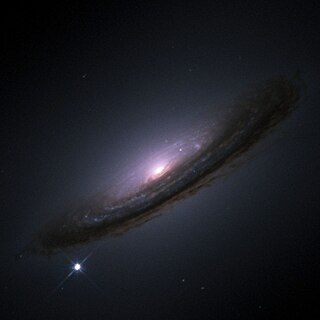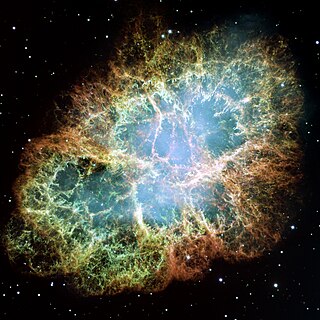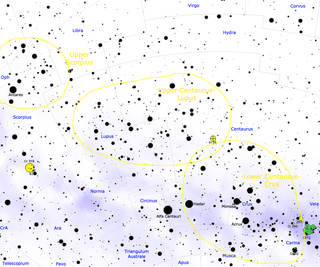
A supernova is a powerful and luminous explosion of a star. A supernova occurs during the last evolutionary stages of a massive star, or when a white dwarf is triggered into runaway nuclear fusion. The original object, called the progenitor, either collapses to a neutron star or black hole, or is completely destroyed to form a diffuse nebula. The peak optical luminosity of a supernova can be comparable to that of an entire galaxy before fading over several weeks or months.

Observations show that the expansion of the universe is accelerating, such that the velocity at which a distant galaxy recedes from the observer is continuously increasing with time. The accelerated expansion of the universe was discovered in 1998 by two independent projects, the Supernova Cosmology Project and the High-Z Supernova Search Team, which used distant type Ia supernovae to measure the acceleration. The idea was that as type Ia supernovae have almost the same intrinsic brightness, and since objects that are farther away appear dimmer, the observed brightness of these supernovae can be used to measure the distance to them. The distance can then be compared to the supernovae's cosmological redshift, which measures how much the universe has expanded since the supernova occurred; the Hubble law established that the farther away that an object is, the faster it is receding. The unexpected result was that objects in the universe are moving away from one another at an accelerating rate. Cosmologists at the time expected that recession velocity would always be decelerating, due to the gravitational attraction of the matter in the universe. Three members of these two groups have subsequently been awarded Nobel Prizes for their discovery. Confirmatory evidence has been found in baryon acoustic oscillations, and in analyses of the clustering of galaxies.

In modern physical cosmology, the cosmological principle is the notion that the spatial distribution of matter in the universe is uniformly isotropic and homogeneous when viewed on a large enough scale, since the forces are expected to act equally throughout the universe on a large scale, and should, therefore, produce no observable inequalities in the large-scale structuring over the course of evolution of the matter field that was initially laid down by the Big Bang.

A blue supergiant (BSG) is a hot, luminous star, often referred to as an OB supergiant. They are usually considered to be those with luminosity class I and spectral class B9 or earlier, although sometimes A-class supergiants are also deemed blue supergiants.

The Loop I Bubble is a cavity in the interstellar medium (ISM) of the Orion Arm of the Milky Way. From our Sun's point of view, it is situated towards the Galactic Center of the Milky Way galaxy. Two conspicuous tunnels connect the Local Bubble with the Loop I Bubble cavity. The Loop I Bubble is a supershell.

The Lambda-CDM, Lambda cold dark matter, or ΛCDM model is a mathematical model of the Big Bang theory with three major components:
- a cosmological constant, denoted by lambda (Λ), associated with dark energy
- the postulated cold dark matter, denoted by CDM
- ordinary matter

The Local Interstellar Cloud (LIC), also known as the Local Fluff, is an interstellar cloud roughly 30 light-years (9.2 pc) across, through which the Solar System is moving. This feature overlaps with a region around the Sun referred to as the solar neighborhood. It is unknown whether the Sun is embedded in the Local Interstellar Cloud, or is in the region where the Local Interstellar Cloud is interacting with the neighboring G-Cloud. Like the G-Cloud and others, the LIC is part of the Very Local Interstellar Medium which begins where the heliosphere and interplanetary medium end, the furthest that probes have traveled.

In astronomy a superbubble or supershell is a cavity which is hundreds of light years across and is populated with hot (106 K) gas atoms, less dense than the surrounding interstellar medium, blown against that medium and carved out by multiple supernovae and stellar winds. The winds, passage and gravity of newly born stars strip superbubbles of any other dust or gas. The Solar System lies near the center of an old superbubble, known as the Local Bubble, whose boundaries can be traced by a sudden rise in dust extinction of exterior stars at distances greater than a few hundred light years.

A near-Earth supernova is an explosion resulting from the death of a star that occurs close enough to the Earth to have noticeable effects on Earth's biosphere.
Naturally occurring iron (26Fe) consists of four stable isotopes: 5.845% of 54Fe (possibly radioactive with a half-life over 4.4×1020 years), 91.754% of 56Fe, 2.119% of 57Fe and 0.286% of 58Fe. There are 24 known radioactive isotopes, the most stable of which are 60Fe (half-life 2.6 million years) and 55Fe (half-life 2.7 years).

The Scorpius–Centaurus association is the nearest OB association to the Sun. This stellar association is composed of three subgroups and its distance is about 130 parsecs or 420 light-years. Analysis using improved Hipparcos data has brought the number of known members to 436. The cluster shows a continuous spread of stars with no apparent need for subclassification.

Gravitational-wave astronomy is a subfield of astronomy concerned with the detection and study of gravitational waves emitted by astrophysical sources.

In cosmology, the steady-state model or steady state theory is an alternative to the Big Bang theory. In the steady-state model, the density of matter in the expanding universe remains unchanged due to a continuous creation of matter, thus adhering to the perfect cosmological principle, a principle that says that the observable universe is always the same at any time and any place.
BD+43 3654 is a massive luminous blue supergiant runaway star in the constellation Cygnus.
WR 142 is a Wolf-Rayet star in the constellation Cygnus, an extremely rare star on the WO oxygen sequence. It is a luminous and very hot star, highly evolved and close to exploding as a supernova. It is suspected to be a binary star with a companion orbiting about 1 AU away.

WR 102 is a Wolf–Rayet star in the constellation Sagittarius, an extremely rare star on the WO oxygen sequence. It is a luminous and very hot star, highly evolved and close to exploding as a supernova.
The "axis of evil" is a name given to the apparent correlation between the plane of the Solar System and aspects of the cosmic microwave background (CMB). It gives the plane of the Solar System and hence the location of Earth a greater significance than might be expected by chance – a result which has been claimed to be evidence of a departure from the Copernican principle as assumed in the concordance model.
George Michael Fuller is an American theoretical physicist, known for his research on nuclear astrophysics involving weak interactions, neutrino flavor-mixing, and quark matter, as well as the hypothetical nuclear matter.

Henize 70 (N70) is a faint emission nebula and superbubble located in the Large Magellanic Cloud. It is located in the constellation of Dorado.
















